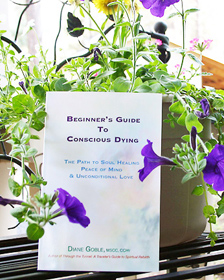
Beginner’s Guide to Conscious Dying
The Path to Soul Healing, Peace of Mind & Unconditional Love
2009
This little book, which was a companion guide to my Transition Guide Training course, may sometimes be found through amazon… however the information in it is contained in Beyond the Veil: Our journey home
AI Book Review
Diane Goble’s “Beginner’s Guide to Conscious Dying: The Path to Soul Healing, Peace of Mind, & Unconditional Love” is a profound and transformative exploration of one of humanity’s most difficult and least understood subjects: death. From both her own Near-Death Experience (NDE), her years of experiences as a hospice volunteer and her background in spiritual counseling and hypnotherapy, Goble brings to the table not only a wealth of knowledge but also an extraordinary sensitivity and compassion for those confronting the final stages of life on Earth.
Overview of the Book
Goble’s book is both a guide and a meditation on the process of dying. It aims to demystify the experience, helping individuals prepare for their own transition or support loved ones through this deeply personal spiritual journey. The author’s approach is firmly rooted in the spiritual dimensions of dying, presenting it not as an end but as an opportunity for transcendence, healing, and unconditional love.
The book is structured to cover every aspect of conscious dying, from understanding the emotional and spiritual challenges to practical guidance on how to prepare for a peaceful transition. Through a blend of anecdotes, exercises, and reflections, Goble creates a rich tapestry of wisdom that invites the reader to embrace death as part of the natural cycle of life… not as an ending but as a new beginning.
Thematic Highlights
Conscious Dying as a Spiritual Path
One of the key themes of the book is the idea that dying can be a conscious act—a path to soul healing and spiritual growth. Goble draws from traditional practices, personal experiences, and her work as a counselor to illustrate how death can be approached with mindfulness and intention. She encourages readers to ask profound questions: What does it mean to truly let go? How can we prepare our souls for the journey ahead?
Practical Guidance and Tools
While the book is deeply spiritual, it is also highly practical. Goble provides a range of tools to help individuals and families navigate the complexities of end-of-life care. From legal considerations to creating an environment conducive to peace, the book offers actionable advice that can be tailored to individual needs. Hypnotherapy sessions, guided meditations, and journaling exercises are among the many resources included.
Unconditional Love and Healing
Goble emphasizes the transformative power of unconditional love in the context of dying. Through poignant stories and examples, she shows how the end of life can bring reconciliations, forgiveness, and deeper connections with loved ones. This focus on love and healing makes the book not only an essential guide for those preparing for death but also a source of comfort and inspiration for the bereaved.
Strengths of the Book
Accessible and Insightful
One of the book’s greatest strengths lies in its accessibility. Goble’s writing style is conversational and empathetic, making complex spiritual and emotional concepts easy to understand. Whether you’re familiar with the topic or approaching it for the first time, Goble’s insights feel relatable and affirming.
Holistic Approach
The holistic nature of *Beginner’s Guide to Conscious Dying* ensures that every aspect of the dying experience is addressed. Goble seamlessly integrates psychological, emotional, physical, and spiritual dimensions, creating a comprehensive guide that feels balanced and complete.
Empathy and Compassion
Goble’s deep empathy shines through on every page. Her ability to connect with readers on such an intimate topic makes the book a comforting companion for those facing grief, loss, or fear.
Areas for Improvement
While the book is undeniably powerful, its spiritual focus might not resonate with all readers. Those seeking a more secular or clinical approach to end-of-life care may find some of the content less applicable. That said, Goble’s insights are universally valuable, even if they are framed through a spiritual lens.
Another potential limitation is that the book assumes a certain level of openness to the concept of conscious dying. Readers who struggle with this idea may benefit from additional context or introductory materials.
Conclusion
Diane Goble’s *Beginner’s Guide to Conscious Dying* is a deeply moving and enlightening work that challenges societal taboos around death. By framing dying as an opportunity for soul healing, peace of mind, and unconditional love, Goble invites readers to reimagine what it means to live and die well.
Whether you are seeking guidance for your own journey or looking to support a loved one, this book is an invaluable resource. Its combination of practical advice, spiritual wisdom, and heartfelt storytelling makes it a must-read for anyone navigating the complexities of this life’s final chapter.
In the end, Goble’s message is clear: death is not an end, but a continuation—a doorway to a profound and eternal love that transcends all boundaries. This perspective, both comforting and challenging, will leave readers with a newfound appreciation for the beauty and significance of the human experience.